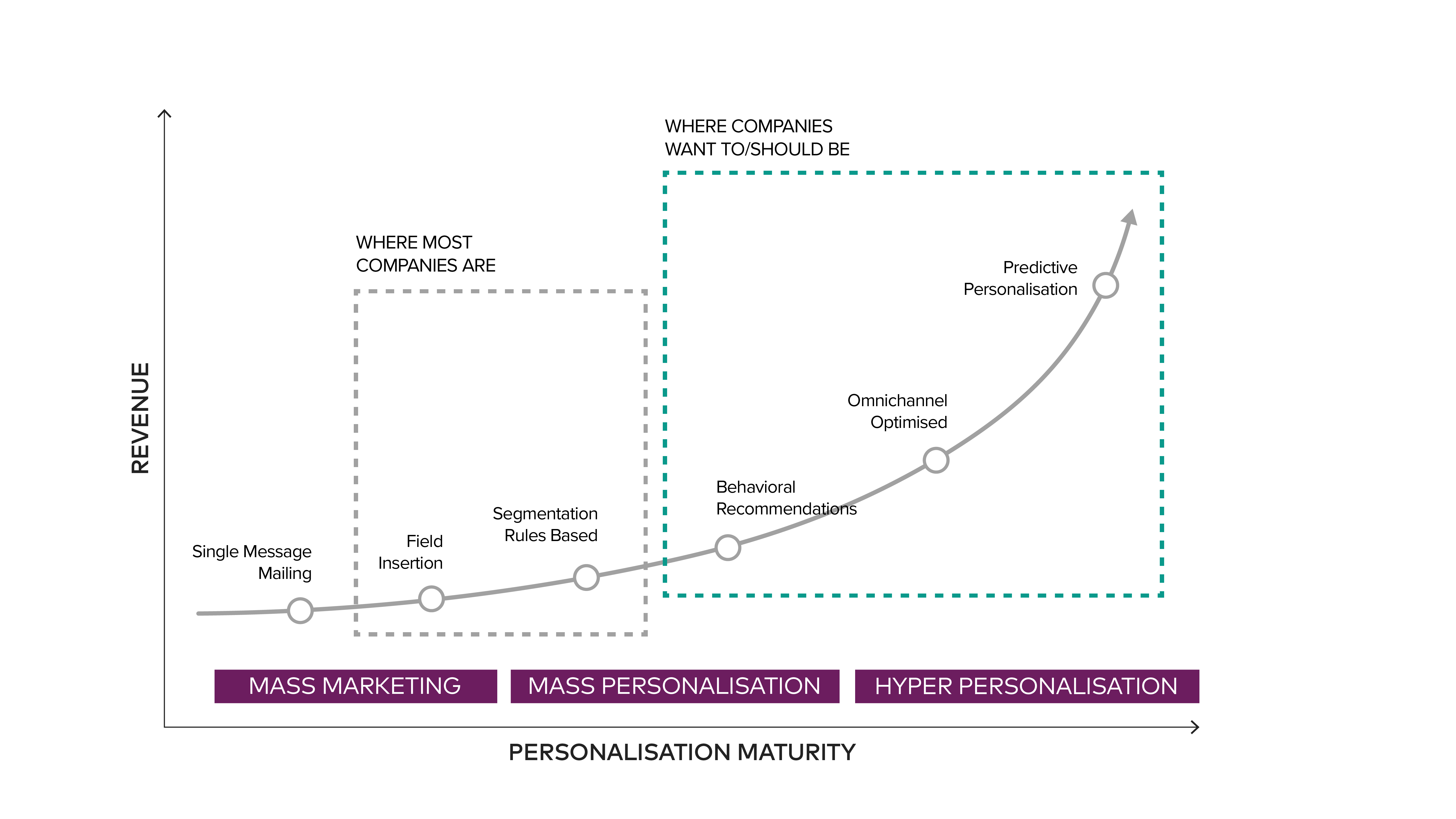For many, the technical capabilities of modern marketing are more frightening than a scary horror movie. After all, everybody heard about (supposedly) eavesdropping computers or insistent (and painfully precise) remarketing solutions. I — a marketer myself — remember my gasp of fear when I first learned that our banking data is planned to empower a futuristic, very (way too) smart marketing AI, which will understand our personal preferences probably better than ourselves.
Luckily, outside this cabinet of monstrosities are many sales solutions that actually help customers. One of the most exciting ones, by far, is hyper-personalisation.
So, What’s This Hyper-Personalisation?
Delivered. The Global Logistics Magazine presents a great example: hyper-personalisation is knowing that the shirt you ordered will definitely fit, because you’ve already seen it on your body in virtual reality*.
More broadly speaking, hyper-personalisation is a way of communicating and targeting online consumers with tailored products and services. But, as the above example shows, it’s more than just adding a name to a generic email campaign about random jeans — next gen Hyper-Personalisation uses data, AI, and advanced algorithms from multichannel sources to precisely customise marketing offerings (e.g. to know that you actually hate jeans and only wear black skirts).
On a more common level, it combines basic behavioral and real-time data a retailer can extract from customers — for example, if a client is browsing a website for business suits, the website can simultaneously recommend matching shirts and ties.


Furthermore, Delivered. states that the 2018 Epsilon study “Power of Me” found that 4 out of 5 customers were more likely to do business with a company if it offered well-targeted, meaningful and personalised products or services. At the same time, another study shows that only 1 out of 5 customers is satisfied with the current level of personalisation from brands.
*Just imagine how this could transform businesses like Zalando, which frequently complain that nearly half of their orders are being returned, significantly driving down profitability.
I’m Interested! Tell Me More!
Many forms of hyper-personalisation can be implemented fairly easily, though some are available only to industry giants. Creating virtual body profiles is, sadly, still a niche idea for the future, but luckily there are other solutions already in wide use — and retail businesses that miss out could be in trouble.
Spot-On Recommendations
As mentioned, smart recommendations are currently the top trend in hyper-personalisation. Amazon, the world’s biggest eCommerce platform, pioneered in introducing an AI product recommendation system based on behavioural characteristics, and it turned out to be an immense success — already in 2013, recommendations generated 35% of all sales on the platform.
Even with such high numbers, there’s still room for growth. Real-time recommendation engines can be very skilled at anticipating seasonal needs and trends, for example recommending relevant men’s grooming products, exclusive sportswear and equipment, vitamins, and more — testing innovative concepts, especially with loyal consumers.
But customised recommendations aren’t the only examples of great hyper-personalisation.
The Flexibility of Design Systems
Many eCommerce businesses have a wide range of potential customers. For example, a general fashion store can be browsed by people of all ages and physical traits. As a result, it’s impossible to please everybody with one webpage or mobile app design.
Yet, even in this case hyper-personalisation is possible — and especially desirable. Using customer data, certain tools can customise the shopping experience — like modern Progressive Web Apps built with Design Systems.
For instance, if a customer is over 6 feet tall (+ 1,8 metres), there’s a reasonable chance his fingers will be bigger than average; in this case, Design Systems can generate oversized buttons to ease navigation on a smart phone. Or, if a client comes from a country which finds a specific colour offensive or intrusive, Design Systems can adjust the look and feel to match cultural expectations.
Furthermore, Design Systems can e.g. personalise the layout to highlight relevant wares based on gender, size calculations and… all other available data.
Voice Recognition
Some businesses still offer placing orders over the phone. Even in this seemly archaic form of shopping, hyper-personalisation can bring benefits for both the consumers and the store.
Using voice recognition, a system can assess the age of the caller. When the customer is young, the system can suggest paying with a mobile app, and if the client is likely older, it can recommend the use of a credit card. Additionally, a calling system can connect male callers with female consultants and vice versa; statistically, people prefer talking to the opposite gender.
Please bare in mind the above are only examples — the full list of hyper-personalisation possibilities is way longer.
But… How Do I Get The Relevant Data?
If you’re asking that question, you’re probably at the beginning of the road.
When it comes to data collection and use, there are generally at least 5 stages of personalisation maturity:
- You don’t have any customer data.
- You collect customer data but use it rarely (or not at all) and the top of your marketing capabilities is an email campaign.
- You collect customer data and perform general A/B tests to improve sales.
- You collect customer data and divide your existing and potential customers into segments/groups of users.
- Ultimately: possessing a vast spectrum of relevant data, you treat every customer individually, achieving true hyper-personalisation.
Don’t feel discouraged if your company doesn’t excel at utilising customer information. For now, true hyper-personalisation is usually achieved only by market leaders. Yet it doesn’t mean that it’s out of reach for small and medium-sized enterprises.


Is This Also A Technological Challenge?
As you can see, hyper-personalisation is more than just a few quick targeting tricks one can apply to boost revenue (like Facebook Pixel). As described in the beginning, hyper-personalisation is actually a way of communicating and operating with a customer-centred approach. Additionally, it also implies utilising relevant technology.
Among necessary solutions are usually the use of Artificial Intelligence and Machine Learning, modern Frameworks based on Design Systems, Cloud solutions, and an advanced, professional User Experience Design.
What Should I Do First?
The suggested approach to get ready to introduce hyper-personalisation to your business would be to:
- Prepare an inventory of the data you’re already gathering (e.g. for personalization or user statistics) and then combine it with data from a sales system (to determine who is actually buying your products, and who’s only browsing your webpage/mobile app) and a churn prevention system (to know what type of customers are loyal to your brand). That way you’ll be able to determine whom to make happy at the first stages of your transition!
- Find out which type of hyper-personalisation may be useful to your customers by planning a dream end-to-end journey, which starts at finding out about your brand in a search engine and ends with the unwrapping of a package at home. Look through hyper-personalisation use-cases if you need more context.
- After you’re ready with the above, define which data you’re lacking and implement solutions that will gather them for you across all channels (after all, you can’t have 3000 data points per session on a single web-app and 500 on mobile, because you’ll likely loose valuable insights).
- Prepare your platform to be ready to technically deliver individual experiences.
- Additionally, integrate the following type of tools to your key systems:
- Marketing orchestration
- Funnel management
- Email campaigning
- Main Data Platform
- CRM
- MobileApp
- WebApp
- Ordering and Warehouse management (to order what is recommended)
- Finally, Utilise MLOps to re-train and improve your deep-learning networks with new data.
After implementation, combine user behaviour with the content changes and user interface to assess the results. Remember to test different variations, automate everything possible, and let AI help you with all the tests.
Closing Remarks
Luckily, most eCommerce businesses already possess semi-automated selling systems which operate at least on basic levels of data maturity. The next step would be to enhance these solutions to a higher level of customer awareness to offer tailored products and services.
And if you’re at the bottom of personalisation maturity, remember: a journey of thousand miles begins with a single step!
—
Thank you to Maciej Mazur (Chief Data Scientist), Łukasz Panusz (Chief Solutions Architect) and Michał Hans (Development Manager) for their expert knowledge and professional guidance.
—
Additional sources:
https://www.dhl.com/global-en/home/about-us/delivered-magazine/articles/2019/issue-3-2019/hyper-personalization-explained.html
https://www.thehouseofmarketing.be/blog/why-personalized-customer-experience-should-be-top-agenda-innovation
https://www.capgemini.com/consulting-fr/wp-content/uploads/sites/31/2017/08/hyperpersonnalisation_vs_segmentation_english_05-01-2017.pdf





